Octet rule Study guides, Class notes & Summaries
Looking for the best study guides, study notes and summaries about Octet rule? On this page you'll find 411 study documents about Octet rule.
Page 4 out of 411 results
Sort by
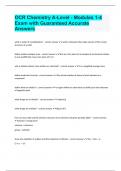
-
OCR Chemistry A-Level - Modules 1-4 Exam with Guaranteed Accurate Answers
- Exam (elaborations) • 10 pages • 2024
-
- $11.49
- + learn more
what is water of crystallisation? - correct answer water molecules that make up part of the crystal structure of a solid define relative isotopic mass - correct answer the ass of an atom of an isotope of an element relative to one twelfth the mass of an atom of C-12 why is relative atomic mass written as a decimal? - correct answer it is a weighted average mass define molecular formula - correct answer the actual number of atoms of each element in a compound define what an orbital is...
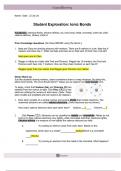
-
Student Exploration: Ionic Bonds Questions with Verified Answers
- Exam (elaborations) • 8 pages • 2023
- Available in package deal
-
- $4.49
- + learn more
Vocabulary: chemical family, electron affinity, ion, ionic bond, metal, nonmetal, octet rule, shell, valence electron, ♫heavy metal ♫ Prior Knowledge Questions (Do these BEFORE using the Gizmo.) 1. Nate and Clara are drawing pictures with markers. There are 8 markers in a set. Nate has 9 markers and Clara has 7. What can Nate and Clara do so that each of them has a full set? Nate gives one to Clara 2. Maggie is sitting at a table with Fred and Florence. Maggie has 10 markers, but Fred ...
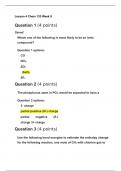
-
CHEM133 Week 9 Lesson 4 Quiz
- Exam (elaborations) • 12 pages • 2023
- Available in package deal
-
- $32.12
- + learn more
1. Question: Which one of the following is most likely to be an ionic compound? 2. Question: The phosphorus atom in PCl3 would be expected to have a 3. Question: The phosphorus atom in PCl3 would be expected to have a give CH3Cl and hydrogen chloride. 4. Question: How many of the following molecules have no dipole moment? 5. Question: Atoms having equal or nearly equal electronegativities are expected to form 6. Question: Element A has an electronegativity of 0.8 and element B has an electr...
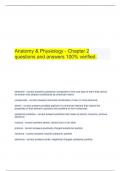
-
Anatomy & Physiology - Chapter 2 questions and answers 100% verified
- Exam (elaborations) • 7 pages • 2023
-
- $12.99
- + learn more
Anatomy & Physiology - Chapter 2 questions and answers 100% verified. elements - correct ance composed of only one type of atom that cannot be broken into simpler constituents by chemical means compounds - correct cal combination of two or more elements atoms - correct est particle of a chemical element that retains the properties of that element; particles that combine to form molecules subatomic particles - correct cles that make up atoms; neutrons, protons, electrons nucleus - correc...
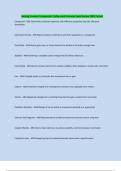
-
Naming Covalent Compounds: Prefixes and Formulas Exam Review 100% Correct
- Exam (elaborations) • 3 pages • 2024
-
- $10.99
- + learn more
Naming Covalent Compounds: Prefixes and Formulas Exam Review 100% Correct Compound - ANS-Chemically combined elements with different properties than the elements themselves Chemical Formula - ANS-Representation of elements and their quantities in a compound Octet Rule - ANS-Atoms gain, lose, or share electrons to achieve a full outer energy shell Stability - ANS-Achieving a complete outer energy level of valence electrons Ionic Bonds - ANS-Atoms transfer electrons to achieve stability, of...
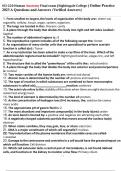
-
SCI-220 Human Anatomy Final exam (Nightingale College ) Online Practice 2023 A Questions and Answers (Verified Answers)
- Exam (elaborations) • 12 pages • 2024
- Available in package deal
-
- $9.49
- + learn more
1. From smallest to largest, the levels of organization of the body are:: chemi- cal, organelle, cellular, tissue, organ, system, organism. 2. The lungs are located in the:: thoracic cavity 3. A plane through the body that divides the body into right and left sides is called:: Sagittal 4. The number of abdominal regions is:: 9 5. The reproductive system includes all of the following except the: Ureter 6. An organization of many similar cells that are specialized to perform a certain functio...
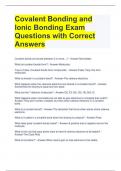
-
Covalent Bonding and Ionic Bonding Exam Questions with Correct Answers
- Exam (elaborations) • 3 pages • 2023
- Available in package deal
-
- $8.89
- + learn more
Covalent Bonding and Ionic Bonding Exam Questions with Correct Answers Covalent bonds are bonds between 2 or more....? - Answer-Nonmetals. What do covalent bonds form? - Answer-Molecules. True or False. Covalent bonds form compounds. - Answer-False, they only form molecules. What is shared in a covalent bond? - Answer-The valence electrons. What happens when the valences electrons are shared in a covalent bond? - AnswerSometimes the sharing is equal and non-polar. What are the 7 diat...
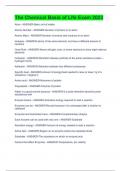
-
The Chemical Basis of Life Exam 2023
- Exam (elaborations) • 5 pages • 2023
-
- $10.49
- + learn more
Atom - ANSWER-Basic unit of matter Atomic Number - ANSWER-Number of protons in an atom Atomic Mass - ANSWER-Number of protons and neutrons in an atom Isotopes - ANSWER-atoms of the same element, but have a different amount of neutrons Octet Rule - ANSWER-Atoms will gain, lose, or share electrons to have eight valence electrons Cohesion - ANSWER-Attraction between particles of the same substance (water→ hydrogen bond) Adhesion - ANSWER-Attraction between two different substanc...
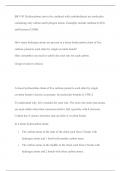
-
BIO 181 Hydrocarbons (not to be confused with carbohydrates) are molecules containing only
- Summary • 2 pages • 2024
-
- $7.99
- + learn more
BIO 181 Hydrocarbons (not to be confused with carbohydrates) are molecules containing only BIO 181 Hydrocarbons (not to be confused with carbohydrates) are molecules containing only carbon and hydrogen atoms. Examples include methane (CH4) and benzene (C6H6).How many hydrogen atoms are present in a linear hydrocarbon chain of five carbons joined to each other by single covalent bonds?Hint: remember you need to satisfy the octet rule for each carbon.Group of answer choicesA linear hydrocarbon ch...
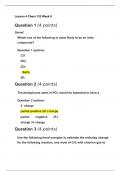
-
CHEM133 Week 9 Lesson 4 Quiz
- Exam (elaborations) • 12 pages • 2023
-
- $32.49
- + learn more
1. Question: Which one of the following is most likely to be an ionic compound? 2. Question: The phosphorus atom in PCl3 would be expected to have a 3. Question: The phosphorus atom in PCl3 would be expected to have a give CH3Cl and hydrogen chloride. 4. Question: How many of the following molecules have no dipole moment? 5. Question: Atoms having equal or nearly equal electronegativities are expected to form 6. Question: Element A has an electronegativity of 0.8 and element B has an electr...

Did you know that on average a seller on Stuvia earns $82 per month selling study resources? Hmm, hint, hint. Discover all about earning on Stuvia


